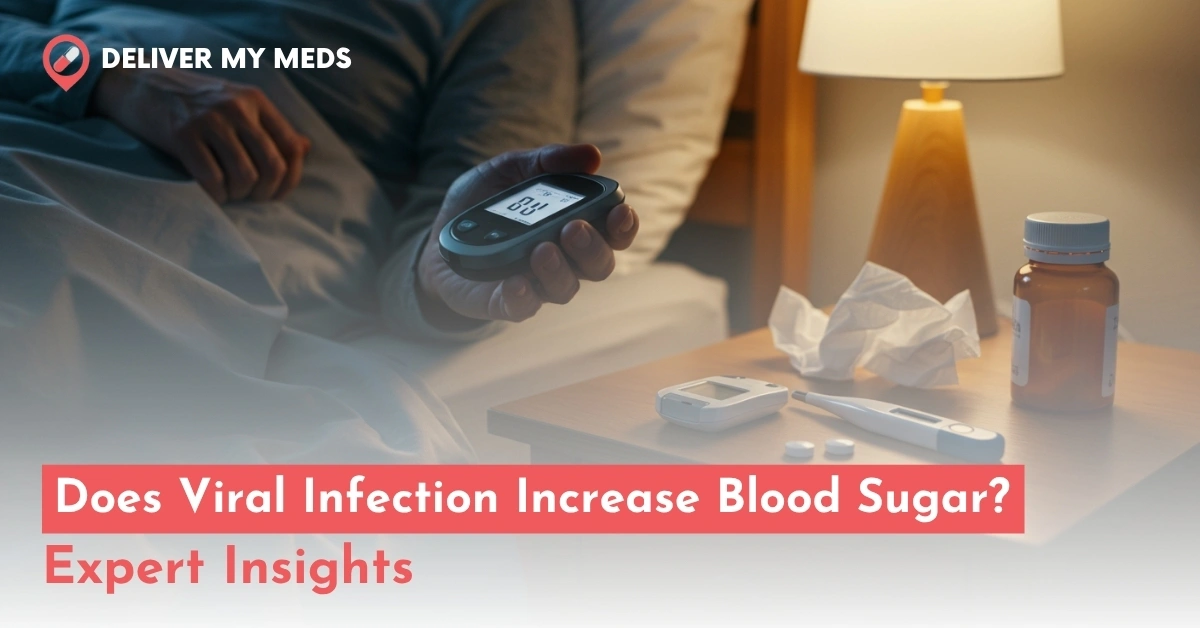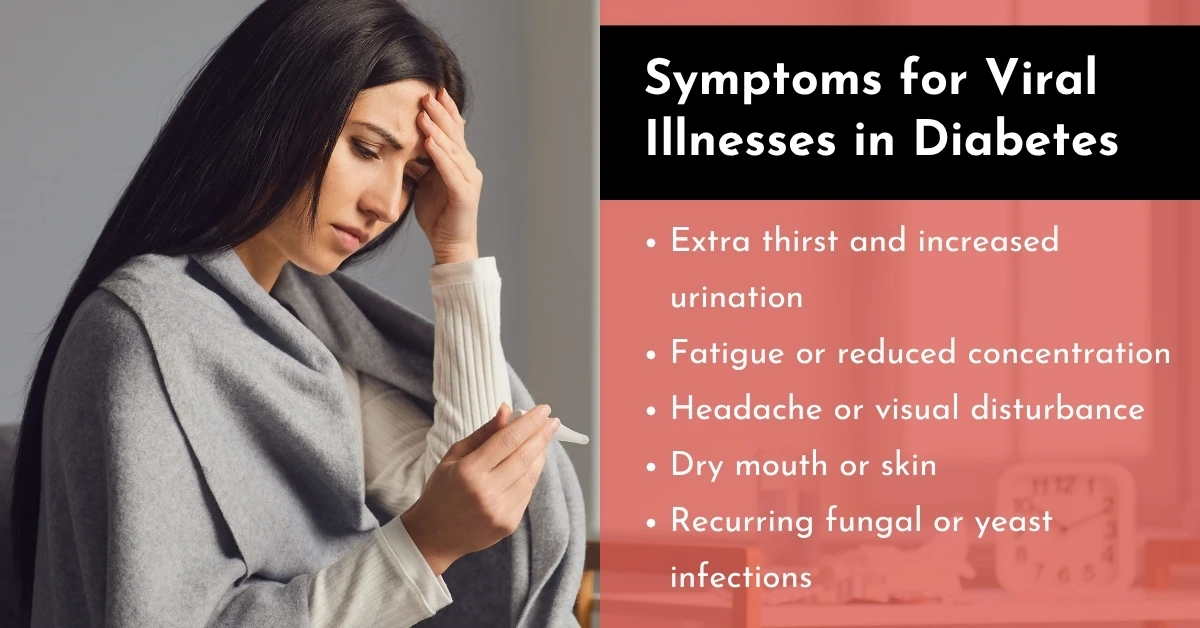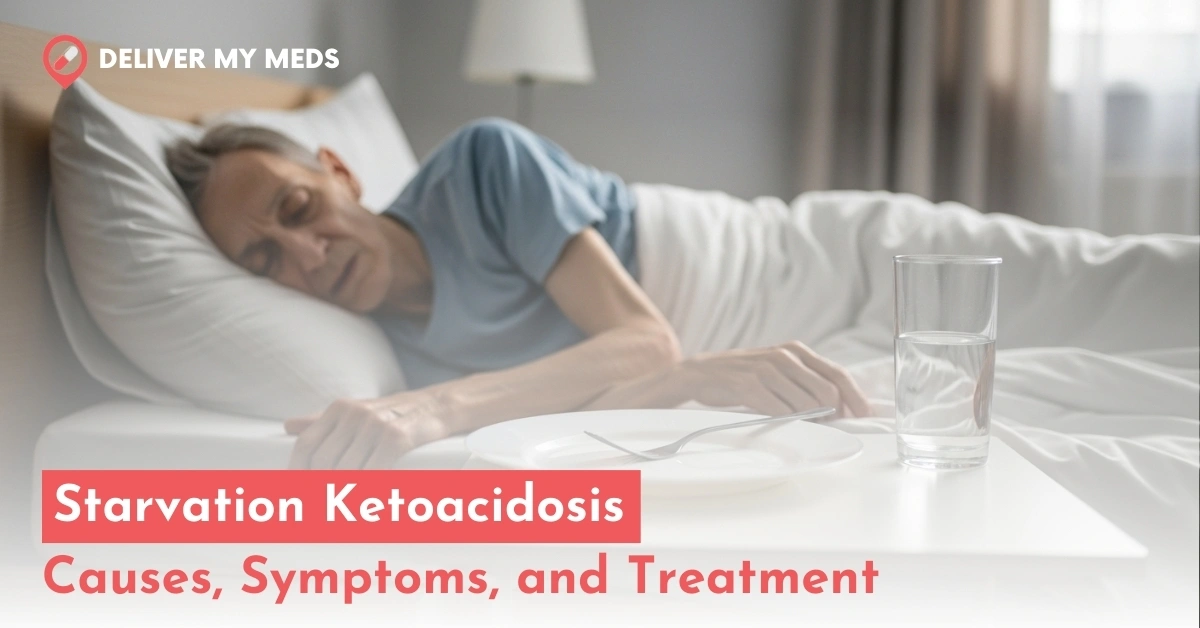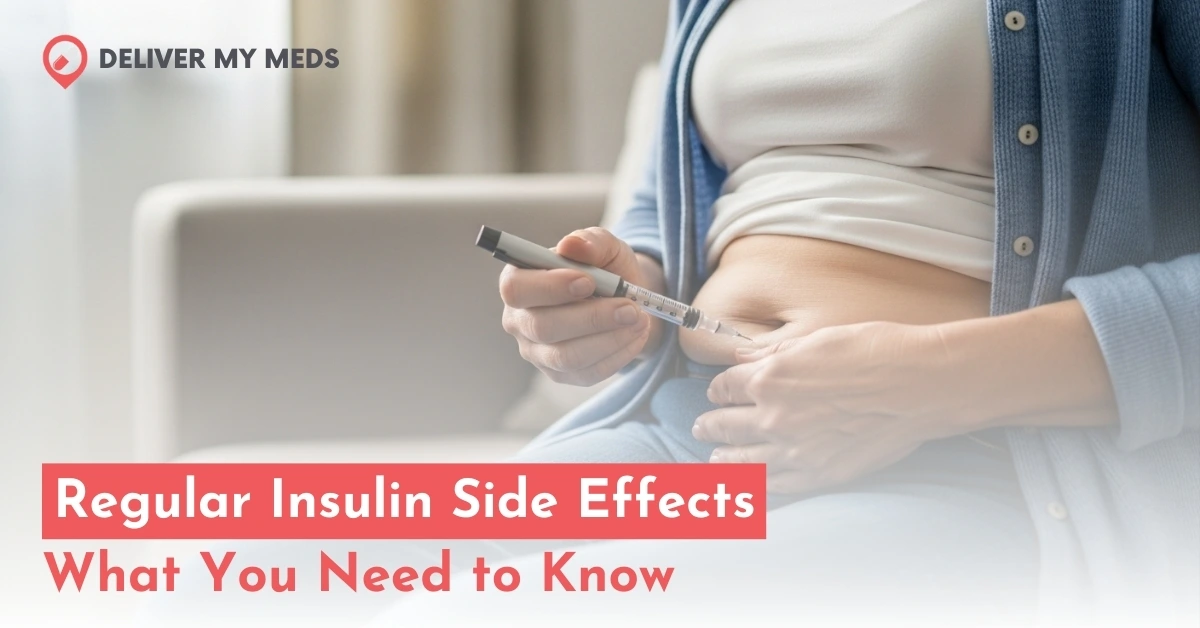
More than one in four adults with diabetes experience worsened viral illness outcomes. That’s because viral infection increases blood sugar, and higher complication rates are strongly associated with poor glycemic control. During illness, Blood sugar increases due to stress hormones, systemic inflammation, and insulin resistance triggered during the immune response. These metabolic shifts can push glucose well above baseline, even in previously non-diabetic people. That’s why routine monitoring using DMM glucose tracking tools is strongly advised during illness.
This article explains how viral infections can raise blood sugar levels, the risk of diabetic ketoacidosis (DKA), and highlights high-risk viruses like influenza, cytomegalovirus, and enteroviruses. It also answers common questions like “Is sugar bad when you’re sick?” and provides practical sick-day tips to help prevent complications.
Does Illness Affect Blood Glucose Levels: How?
Infection places physical stress on the body, leading to a chain of hormonal and immune responses that disrupt glucose balance. In people with diabetes, these effects are stronger and harder to manage. Yes, illness does affect blood glucose levels, primarily by increasing the production of glucose in the liver and reducing the effectiveness of insulin in the body.
When you’re sick, your body releases stress hormones like epinephrine, cortisol, glucagon, and growth hormone. These hormones help fight infections but also raise blood sugar by prompting the liver to release more glucose and making muscle and fat cells more insulin-resistant. At the same time, the immune system releases cytokines, which can also reduce insulin sensitivity.
In addition, bed rest and reduced movement lower muscle glucose uptake, which further contributes to high sugar levels, especially in individuals already living with insulin resistance.
- In U.S. hospitals, viral infections raise fasting blood sugar by 40-80 mg/dL, a pattern widely documented in ICU protocols for stress-related hyperglycemia (BMC Pulmonary Medicine, 2025).
Key Triggers Behind Illness-Related Blood Sugar Spikes
| Factor | What It Does |
| Epinephrine | Raises glucose by triggering liver sugar release and increasing insulin demand |
| Cortisol | Increases glucose production, lowers insulin sensitivity during infection |
| Glucagon | Stimulates liver glucose output, opposes insulin’s effect |
| Cytokines (e.g., IL-6) | Reduce insulin signaling, worsen blood sugar control |
| Inactivity/Bed Rest | Decreases the muscle use of glucose, leading to higher levels in the blood |
How Viral Infections Interact: Comparing Normal vs. Diabetic Response
In healthy individuals, the pancreas can produce enough insulin to balance all of the above-given factors. In people with diabetes, especially those with poor baseline control, it leads to diabetic ketoacidosis (DKA).
Here’s what viral infections mean for the regular vs diabetic immune system:
| Aspect | Healthy Immune System | Immune System with Diabetes |
| Everyday Defense | The body quickly spots and fights off viruses using skin, white blood cells, and immune memory. | High blood sugar slows down how fast the immune system recognises and reacts to infections. |
| White Blood Cells | White blood cells find and kill viruses efficiently. | High sugar levels make white blood cells slower and less effective. |
| Inflammation | Swelling and fever go away once the virus is gone. | Inflammation lasts longer and makes it harder to heal. |
| Response to Vaccines | Most people build strong protection after getting vaccinated. | People with poorly controlled diabetes may get less benefit from vaccines. |
| Virus Recovery | Illness is mild and clears quickly, with long-term immunity. | Infections can last longer and be more severe due to a slower immune response. |
| Blood Sugar During Illness | Blood sugar may go up briefly, but usually returns to normal after recovery. | Illness causes sharp spikes in blood sugar and may trigger complications like DKA. |
| Skin Protection | Healthy skin keeps out germs effectively. | Poor circulation or nerve damage can lead to skin breakdown and an higher risk. |
Viral Illnesses Lead to High Blood Sugar: Symptoms and Causes
Acute viral infections can destabilise blood sugar levels. However, even in those without diabetes, illness can prompt temporary hyperglycemia due to immune-mediated hormonal shifts. The answer to “Does viral infection increase blood sugar in non diabetics?” is yes, though usually short-lived. This effect becomes more concerning in the context of diabetes, where insulin regulation is already impaired.
| Infection | Why It Raises Blood Sugar | Additional Risk in Diabetes |
| Influenza | Promotes systemic inflammation and increases stress hormones | Elevates the risk of DKA and prolonged glucose instability |
| COVID-19 | Triggers cytokine storms, damages beta cells in some cases | Associated with new-onset diabetes and severe dysglycemia |
| Pneumonia | Heightens insulin resistance through immune activation | Requires insulin dose modification or hospitalisation |
| Urinary Tract Infections (UTIs) | Inflammation + dehydration = glucose elevation | The common cause of unrecognised hyperglycemia in T2D |
| Skin or soft tissue infections | Reduced mobility, inflammation raised levels | Impaired wound healing further worsens glycemic status |
Recognising Progression: From Elevated Blood Sugar to Medical Risk
During illness, glucose levels go higher, which can escalate if insulin needs rise and are not met. Symptoms differ based on the individual but follow a consistent clinical pattern. Early signs of infection-related hyperglycemia may include:
- Extra thirst and increased urination
- Fatigue or reduced concentration
- Headache or visual disturbance
- Dry mouth or skin
- Recurring fungal or yeast infections
Also, keep an eye out for warning signs of potential DKA:
- Nausea, vomiting, or abdominal discomfort
- Labored or rapid breathing
- Detectable ketones in blood or urine
- Fruity breath odor
- Confusion or slowed cognition
- Persistent blood glucose >250 mg/dL despite correction
How to Manage Blood Glucose and Support Immunity
Below are foundational measures for early-stage illness. A more detailed sick-day protocol is given below:
- Continue all prescribed medications, including insulin or oral agents, unless advised otherwise by your physician, even if appetite is reduced or vomiting occurs.
- Do not attempt to aggressively lower mildly increased glucose during viral illness. Levels between 140-220 mg/dL help fuel immune cells and preserve cerebral glucose delivery. Attach CGM sensors like FreeStyle Libre 2 Plus for accurate readings.
- Avoid sharing injection devices or glucose monitors; disinfect all reusable tools between uses to reduce infection risk.
- Supplement with vitamin D if levels are low or insufficient dietary/sun exposure exists.
10 Steps Sick Day Plan: Managing Blood Sugar and Viral Illness
A sick day plan is important if you have a viral infection as a diabetic person. It outlines steps to maintain glucose control and reduce infection risks when you’re unwell. Use this protocol to monitor trends, adjust therapies, and support your immune response. See how to boost a weak immune system. Below are ten essential actions, each backed by clinical research, to include in your diabetes sick day plan.
1. Maintain Adequate Hydration
Hydrate with 8 oz of water per hour to avoid glucose spikes. Dehydration reduces plasma volume and elevates glycemia. Monitor intake, and sip sugar-free, caffeine-free drinks every 15 minutes when fever or diarrhoea occurs.
2. Preserve Regular Meal Timing
Consume meals or small snacks at usual intervals, even if the appetite is low. Skipping meals or eating once daily worsens glycemic variability (source: PLOS ONE 2024). Go for balanced nutrients, protein, healthy fats, and fiber to stabilize glucose and support immunity without abrupt metabolic swings.
3. Select Nutrient-Dense, Balanced Foods
Include high-fiber vegetables, lean protein, and whole grains to modulate postprandial glucose. Small portions of bland, nutrient-rich items (oatmeal, broth, yogurt) aid tolerability during gastrointestinal symptoms. This approach addresses “Does not eating raise blood sugar?” as yes, it does.
4. Prioritize Restorative Sleep
Sleep 7+ hours nightly for better rest, or follow the core sleep. Sleep deprivation damages insulin sensitivity and glucose tolerance. Establish a consistent sleep schedule, minimise screen exposure before bedtime, and get morning light to reinforce circadian rhythms.
5. Increase Monitoring Frequency
Check blood glucose every four hours, or every two hours if you have type 1 diabetes, alongside daily temperature, weight, and ketones (ADA Standards 2025). Early detection allows timely treatment and prevents progression to DKA. Our DMM FreeStyle Libre 3 Plus sensors provide real-time trends with free home delivery. Check insurance coverage today.
6. Stay Current with Vaccinations
Make sure that all age-appropriate vaccines are up to date, like COVID-19, influenza, pneumococcal, hepatitis B, and others. Vaccination reduces infection severity and subsequent glycemic deterioration. Discuss booster eligibility annually with your healthcare provider.
7. Try Stress-Relief Activities
Do short calming activities like deep breathing or meditation to lower stress hormones (cortisol and epinephrine). Just 5 minutes of meditation can counter stress and help regulate blood sugar.
8. Wash Your Hands Properly
Wash hands thoroughly (for 20-30 seconds) with soap after coughing, eating, or bathroom. Good handwashing helps stop the spread of viruses and cuts down on repeated infections, which helps keep your blood sugar steady.
9. Move a Little When You Can
If you’re feeling up to it, light movement like walking or stretching can help your body use insulin better and move sugar into your muscles (source: Colberg et al., 2016, Diabetes Care). Don’t do heavy exercise if you have a fever or feel sick, as it can put too much strain on your heart.
10. Know Your Family History
Your genes play a big role in how your body handles blood sugar and fights off infections. If diabetes or immune issues run in your family, that puts you at higher risk. Research shows these traits can be passed down and affect both insulin use and how your body responds to illness.
When to Contact Your Healthcare Provider During Illness
The complications of diabetes can recur in viral infections, especially those whose glucose levels are affected. Seek medical attention without delay if your blood sugar levels exceed 240 mg/dL or glucose levels go below 54 mg/dL. Extended fever, confusion, or dehydration also requires prompt evaluation. These symptoms show the body’s inability to manage infection or metabolic stress safely.
To help improve outcomes, DMM offers glucose monitoring devices with free at-home delivery. It is also possible to determine the device’s coverage by insurance prior to deciding. The earlier detection of illness is the most efficient method to avoid problems. A well-planned sick day plan and the right tools keep you protected during sickness, even if you’re diabetic.





